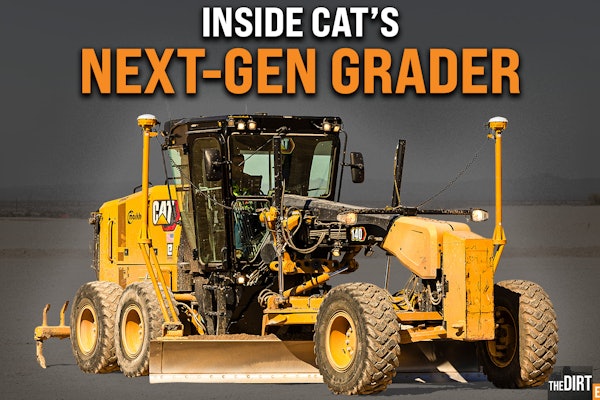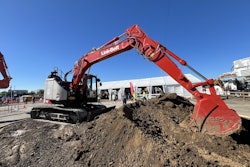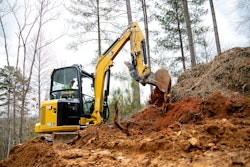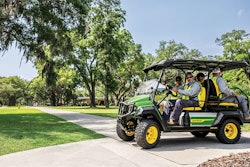From the moment a dozer, crawler loader or excavator hits the dirt, the steel components in its undercarriage begin to slowly wear themselves down. And while manufacturers continue to develop technology that helps extend the life of these components, the critical factor is you – how well you spec and maintain these components and how well your operators take care of them.
Steel track undercarriages represent the biggest single lifecycle cost on dozers and crawler loaders – roughly 50 percent. Excavator undercarriages, because they travel less, fare better, with track costs accounting for roughly 30 to 35 percent of the machines’ total lifecycle costs.
“Equipment costs can make the difference between winning or losing money on a contract,” says Dick Schaefer, senior product manager, Komatsu America. “That’s why big contractors get big – not because they’re lucky – because they’re good at figuring these things out. And anything you can do to extend the life of the undercarriage is money in the bank.”
Soil conditions impact track life
One variable you can’t control is the soil condition and this has perhaps the biggest impact on the life and longevity of your track.
“If you’re in the southeast, especially in the coastal areas with sand or silica in the soil, then you’re going to have accelerated wear,” says Sam Wyant, excavator product manager, Volvo Construction Equipment. “On an excavator your track life might be anywhere from 3,000 to 6,000 hours. On a dozer that will be shorter. Then you go into the north in clay or loam soils and a lot of times the contractor will get 4,000 to 8,000 hours on an excavator track.”
Rain and moisture in sandy soil can also accelerate wear. “Water and sand together form the perfect lapping compound,” says Jeff Sigmon, customer support advisor for RDO Equipment, a Fort Worth, Texas-based John Deere distributor. Landfills are also hard on dozer undercarriages. “There are bedsprings and fishing line and all sorts of stuff that tears out the seals in the bottom rollers,” Schaefer says. “Debris can also get packed between metal-to-metal contact points and stress the chain.”
Bushings usually the first to go
There are a handful of propriety pin-and-bushing designs, but across the board there are two basic types: sealed (dry chain) and sealed and lubricated (sometimes called SALT track or wet chain). As the name implies, sealed and lubricated pins use an internal coating of oil to reduce abrasion and friction between the pin and the bushing.
“In 95 percent of the cases a wet chain is usually the best option,” says Sigmon. “They’re much quieter. They tend to draw a bit less horsepower. You have more meat in the bushing so you get more bang for your buck.”
When you use less horsepower to move the undercarriage, you have more horsepower available to push dirt and you burn less fuel. “Even though it’s a small amount, when you total it up over six months it becomes important,” says Schaefer.
Another advantage of sealed and lubricated tracks is that once the bushings get worn, they can be turned or repositioned 180 degrees to wear on a fresh surface. This costs money and creates downtime, but it effectively doubles the life of the pin-and-bushing assembly.
Two conditions where a dry chain may be preferable, says Sigmon, are areas with a lot of rocks and trees underfoot (what he calls “a high mountain Colorado environment”) and/or extreme low-ground-pressure situations that require extra wide pads. These conditions combined can exert severe lateral forces on the shoes and weaken the joint between the pin and track link. Enough twisting here can damage the seals and cause lubrication to leak out.
Excavators almost always use dry chains, since loading over the side of the tracks creates enough lateral force on the pins and bushings that it would damage the seals in lubricated pins and bushings. And given the low number of travel hours put on an excavator undercarriage (compared to a dozer that’s moving all the time) the additional cost of sealed and lubricated chain is not warranted.
Grousers change machine’s operating characteristics
Flotation, the ability of the track pads to support the weight of the machine, also has an impact on the life of the undercarriage. “The rule of thumb is to go with as narrow a pad as you can to maintain flotation with your machine,” Wyant says. “That will reduce lateral stress on the tracks.”
The number of grousers on each shoe is usually a given for a particular machine type, but there are exceptions to the rules, and the number of grousers have a big impact on how a machine operates.
The single grouser found on most dozer shoes is the most aggressive design, giving great traction. Double grousers don’t dig in as hard but offer less turning resistance and better maneuverability. Triple grousers provide the best flotation and maneuverability and are common on most excavators. The three bars running across the bottom of the pad also provide beam strength, which helps prevent the shoe from bending during extreme lateral force when the excavator is digging or loading over the side. Excavators that need to climb hills or those used in forestry applications, however, may do better with a double grouser rather than triple.
In abrasive or rocky soils you may also want to consider spec’ing severe service grousers, which are thicker and last longer under harsh conditions. In most conditions, your shoes and grousers will last the life of the undercarriage.
The shape of the outside corners of your grousers also impact the machine’s maneuverability. A square corner gives more turning resistance, says Schaefer. Clipped corners provide some turning assistance and extreme clipped corners are the easiest to turn.
Rollers: Simple but critical elements
Bottom rollers carry the weight of the machine and the top carrier roller supports the track chain between the idler and the drive sprocket. Properly maintained rollers usually last the life of the undercarriage. They may not look like they do much, but if they malfunction they can do irreparable damage to your chain.
As the roller tread surface wears, the flanges grow closer to the link pin boss. Once the flanges touch the pin boss they will start grinding off the softer metal of the pin boss. If this happens it makes it impossible to turn the bushings. If allowed to continue, the flanges will eventually damage the pin end.
The other potential for roller failure is if a seal leaks and the roller loses its internal lubricant, or if mud or grit work their way into the bearing and cause the roller to freeze. When this happens, the chain riding across the roller will quickly file a flat spot on the wear surface of the roller.
“In the optimum world, when I set a machine up to turn, the links are at their half life and the bottom rollers are anywhere from 20 to 35 percent worn,” Sigmon says. “As the link is going down, so is the bottom roller. So it’s best to change the whole thing and go on.”
Sprocket wear must match bushing wear
The concave surfaces in the drive sprockets wear at about the same rate as the pins and bushings, which is why it is essential to replace the sprocket teeth whenever you turn or replace the pins and bushings.
“You don’t want to put a new surface against an old surface,” Schaefer says, “because you’re not going to get the life out of the new surface. The distance between the pins increases over time. That means the bushings start to contact their sprocket segments earlier and wear away a larger surface on the bushing rather than fitting tightly together as when the new bushing slides into the root of a new sprocket.”
“The only time I’ve seen sprockets put on out of sequence is where we’re not quite ready for a bushing turn,” Sigmon says. This can be justified in that sprocket segments are relatively inexpensive and easy to change compared to a bushing turn. “We’ll throw a set of sprocket segments on it to run it out a little bit further.” Sigmon says. “That’s because as the sprocket teeth begin to really sharpen you can actually fracture the tooth when it gets too thin.”
Sprockets and bushings are designed to wear out at the same rate.
Operator’s skill level impacts cost
Caterpillar undercarriage specialist Vito Minneci has a suggestion for how to emphasize the importance of good operation in extending the life of a dozer. “I would change the beep in the backup alarm to the sound of a cash register – ka-ching!,” he says. “Going in reverse is expensive.”
When a tractor is going forward, the bushing’s work is being done at 6 o’clock on the sprocket, Schaefer says. The bushing is not turning in the root of the sprocket tooth. Instead the pin is turning inside the bushing 30 degrees. When going in reverse, the workload is shifted from 6 o’clock to 12 o’clock. “Now we are pulling the undercarriage through the sprocket,” he says. “The bushing is turning inside the root of the sprocket tooth under load and that’s what accelerates wear on the bushing. The other thing is when you’re running in reverse, the chain is getting pulled tight over the front of the idler and you accelerate wear on the idler.”
“Properly trained operators are taught they can save big bucks by using good operating techniques and properly maintaining their machine,” says Tom Neeley, Caterpillar commercial manager for undercarriage marketing. In addition to limiting time spent in reverse, well- trained operators also know not to constantly turn a dozer to one side, but to even out the wear and stress on the track by attempting to perform an equal number of right turns and left turns during the day when possible.
Maintaining a well-balanced machine also helps. When weight is unevenly distributed front to back you’re either overstressing the front idler and rollers or excessively grinding the pins and bushings into the sprocket segments. A lot of uphill travel likewise accelerates wear on the link assemblies and drive sprocket.
The same principles apply to excavators, even though they don’t travel as much as a dozer. Avoid digging over the sides or the rear of an excavator whenever possible. When they’re extended over the sides, the weight of the loaded bucket and the boom and stick exert lateral pressure on the track link assemblies. Likewise, digging over the final drives puts extra strain on the sprocket and pins and bushings. Ditto for traveling. If the weight of the boom and stick is hanging over the final drives during travel, your excavator’s weight distribution is lopsided and you’re grinding the pins and bushings into the sprockets with much more force than is necessary.
Rollers and shoes will usually last the life of the undercarriage, but keep the rollers clean and inspect them frequently to prevent contamination from seizing the bearings.
Maintenance: daily and long-term
In the field there are a few things operators and service techs can do that take little time and add considerably to the longevity of your undercarriage. The simplest maintenance is to regularly clean your undercarriage with a pressure washer. Mud and abrasive soils will pack in around components and act like sandpaper when the machine is moving. Heavy clay, gumbo and debris can come between metal-to-metal contact points and increase chain tension.
Another regular field service task is maintaining the proper chain tension, typically by applying grease to the track adjuster piston. The idler should also be inspected for signs of slack, wear in the bushing, oil leakage and checked to see if it needs reshimming. Specs for chain tension and ways to measure it are spelled out in operator’s manuals, but often you can tell if a chain is too loose or too tight by simply looking at it.
A too-tight chain accelerates wear on all the metal-to-metal contact points and is generally considered one of the worst things you can do to your undercarriage. A chain that’s too loose will tend to buck up the track pads between the last rear roller and the sprocket. “I always tell my customers that you want to be as loose as you can for the soil conditions, but tight enough to keep the chain on,” Sigmon says.
To determine when a chain is ready for turning or replacement, Sigmon says he uses calipers. On a wet chain he’ll measure the link height and the outside diameter (O.D.) of the bushing. “Typically you’re looking for a link height that is less than 50 percent worn on a chain that has never been turned. Normally the percentage of wear is in the high 30s to low 40s percentage of wear. And you’re looking for a bushing O.D. measurement. I like to turn them in the mid-80s.”
On dry chains, Sigmon says he measures the same two components but also measures the pitch, or distance between the pins, across five links for greater accuracy. Sigmon says he prefers manual measurements with calipers, but admits that ultrasonic measuring devices work faster and are especially useful in measuring components that may be difficult to reach with calipers. The one drawback to ultrasonic devices, he says, is that they may be calibrated for brand specific components.
Rollers should also be inspected daily. Look for signs of lubrication leaking out and keep an eye on how close the roller flanges are getting to the pin bosses. At the point when you turn the bushings you’ll probably have a lot of life left in your rollers, but it can be advantageous, Schaefer says, to take the rollers closest to the sprocket and idler (which receive the most wear) and swap those with the roller in the middle to balance out the wear.
Line up your ducks before scheduling a bushing turn
Turning a set of bushings is a big task and that’s where proactive product support people can help you minimize downtime. (These support people are sometimes called product service sales representatives or PSSRs. Deere calls them customer support advisors, or CSAs.) They typically represent the dealer you bought the equipment from, or they might be with independent shops. Their job is to look after the long-term maintenance of their clients’ machinery so that the contractor can focus on his work.
“The PSSR should know when the track press is going to be available,” Schaefer says. He’s prepared with transportation. He knows that the parts are available. He’s going to be living with this thing, measuring the wear and he’s going to know two months ahead of time when it’s ready for turning. He’s got everything lined up so the contractor doesn’t have to worry about it or suffer from excess downtime.”
And since the machine will be out of service during that time, Schaefer adds, that’s a golden opportunity to complete numerous other service needs.
When turning the bushings, Schaefer strongly recommends replacing all the track hardware with new pieces. “The threads on the old bolts stretch, making them harder to keep tight. A loose bolt will damage your link when you get it back out in the field, and you can’t put a new link on that’s 50-percent taller than the rest of the links on the chain.”
Some PSSR’s will omit new hardware in their bids to make the bid look more attractive, Schaefer says. “But it’s a huge mistake.”










